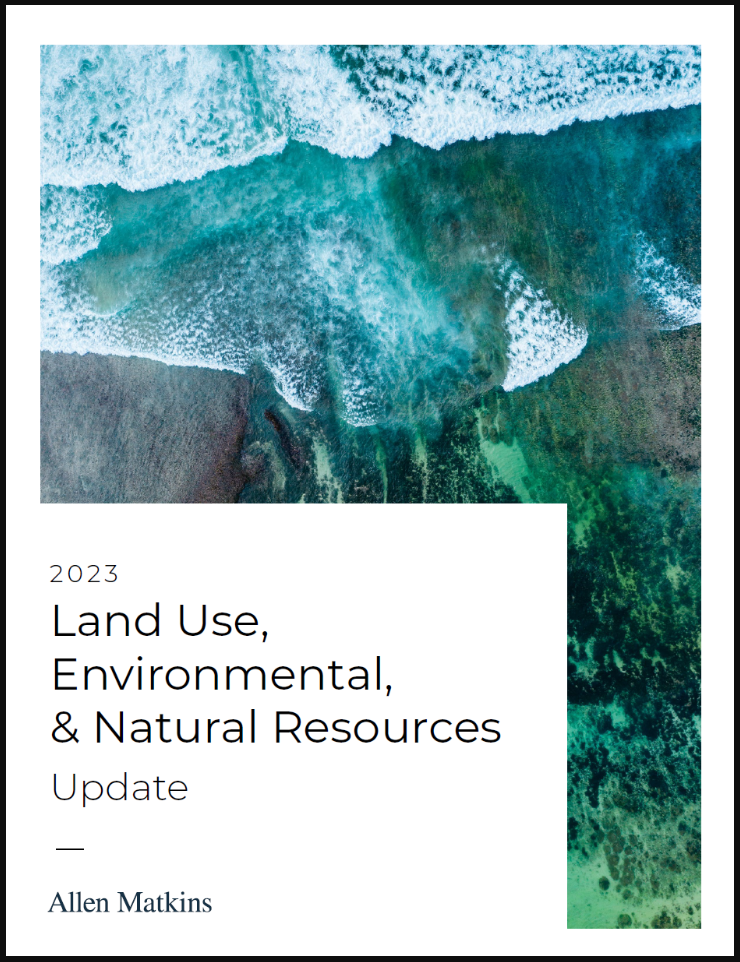News & Insights
2023 Land Use, Environmental, & Natural Resources Update

California’s Offshore Wind Power Industry Sets Sail
Natural Resources
5.01.23
California is entering the new waters of offshore wind power. The unique challenges and potential of developing offshore wind power in California have spurred numerous federal and state cooperation efforts. While other U.S. offshore wind power generating projects, including the handful in operation and planned for the U.S. East Coast, are generally located in shallow waters and anchored to the seafloor, California’s continental shelf geology, which drops off steeply close to shore, will largely require wind power installations on floating platforms. Only a few such floating projects currently exist around the world, located in Europe and Asia at a relatively small scale. According to the U.S. Department of Energy, two thirds of potential wind power resources in the U.S. are located in deep water where floating platforms would be required. To facilitate development of these resources, the U.S. Department of Energy’s Floating Offshore Wind Shot Program has set a goal to deploy 15 gigawatts (“GW”) of floating offshore wind and accelerate cost reductions for floating technologies by more than 70% by 2035.
In September 2021, Governor Gavin Newsom signed AB 525 (Chiu), which required the California Energy Commission (“CEC”) to facilitate the development of offshore wind power facilities. In August 2022, the CEC set offshore wind planning goals of 2-5 GW by 2030 and 25 GW by 2045, creating an opportunity for the wind power industry to expand into new territory. The permitting and construction of floating offshore wind power facilities will be a complex, lengthy process that requires the cooperation of several federal, state, and local agencies.
In December 2022, the federal Department of the Interior’s Bureau of Ocean Energy Management (“BOEM”) auctioned two leases for an area off of Humboldt County in northern California and three leases for areas off of the central coast of California. The winners of the northern California lease auctions were RWE Offshore Wind Holding, LLC and California North Floating, LLC. The winners of the central coast auctions were Equinor Wind US LLC, Central California Offshore Wind LLC, and Invenergy California Offshore LLC. When available, BOEM will post executed leases at the following website: https://www.boem.gov/renewable-energy/lease-and-grant-information.
To assist stakeholders in navigating the coming process, CEC has promulgated a draft Conceptual Permitting Roadmap (“Roadmap”) for offshore wind that contains timeframes and milestones for permitting offshore wind power and associated electric and transmission infrastructure. The Roadmap is at present a draft, preliminary document that will be updated through at least June 2023 and possibly afterward. AB 525 also requires the CEC to develop a full Offshore Wind Strategic Plan by June 30, 2023.
Conceptual Permitting Roadmap
Because the contemplated floating offshore wind generating facilities and related components will be located in federal waters and ultimately connected to onshore facilities through state waters on submerged state lands, the projects will be ultimately subject to federal, state, and local jurisdictions. The Roadmap is intended to facilitate timely, coordinated, and efficient permitting processes among the entities responsible for issuing entitlements and associated environmental review.
BOEM manages development of the nation’s offshore energy and mineral resources under the authority of the federal Outer Continental Shelf Lands Act. BOEM has exclusive authority to grant leases and approve construction and operations plans for renewable energy development in the federal waters of the United States Outer Continental Shelf.
Renewable energy projects in the OCS follow the BOEM’s four-stage permitting process, which can take over 10 years to complete. The four stages are:
-
- Planning and Analysis (identification of offshore wind areas and initial environmental reviews)
- Leasing (issuance of notices, negotiation of lease terms, issuances of leases)
- Site Assessment
- Construction and Operations. For the initial five California offshore lease areas identified by BOEM, the first two stages are essentially complete and therefore the Roadmap focuses on site assessment and construction and operations.
Stage 3 site assessment activities include developing site assessment plans and conducting environmental surveys. BOEM estimates that the site assessment process will take up to six years between lease issuance and construction, with the first year devoted to creation of a “Site Assessment Plan” (“SAP”.) Once the lessees have completed the SAP, BOEM will conduct additional environmental reviews of the proposed projects. BOEM may also conduct additional analysis under the federal National Environmental Policy Act (“NEPA”) if significant new information becomes available after site assessment is complete. Such additional BOEM reviews and analysis could also potentially trigger additional review by the California Coastal Commission. Site assessment activities may also require permits from the California State Lands Commission, the California Department of Fish and Wildlife, and other federal, state, and local agencies. Within 120 days of lease issuance, lessees must develop a communication plan for and hold a meeting with all federal, state, and local agencies with authority related to the lease area. Lessees are also required to develop plans to communicate with local tribes and commercial fishing communities that may be affected. California’s formal permitting and leasing processes, including applications for state tidelands leases and coastal development permits, which require compliance with the California Environmental Quality Act (“CEQA”) via environmental review, have not yet been initiated with regards to offshore wind. The CEC anticipates that the initial surveys taken during the BOEM’s Stage 3 will assist the state lead CEQA agency in describing the environmental baseline and setting against which potential impacts would be measured.
In Stage 4, lessees must submit a detailed Construction and Operations Plan (“COP”) before beginning construction. BOEM has published a checklist that will assist lessees in preparing their COPs and will allow lessees to submit information under a phased approach. Once the COP is finished, BOEM will conduct NEPA review. The Roadmap anticipates that joint CEQA- NEPA review may be possible. Additionally, the California Coastal Commission must approve the COP.
Stakeholder Comments: Revised Roadmap Forthcoming
The vast potential for offshore wind’s contribution to the California grid has attracted a large volume of stakeholders and associated comments on the Roadmap. Industry groups have requested participation in the Roadmap drafting process and have suggested several changes to the draft Roadmap. As described in a comment by American Clean Power California, industry’s “deep technical expertise and experience permitting offshore wind and understanding of the requirements and constructability of offshore wind technologies and associated facilities” is essential to developing a successful, coordinated and efficient permitting process.
Not surprisingly, industry groups have requested further clarity on the specifics of the permitting and entitlement process. Multiple comments requested that a CEQA lead agency be designated for all offshore wind projects. The current draft of the Roadmap does not specify a particular lead agency, and appears to anticipate that the lead agency could change based upon the specifications of the project. Based on our decades of experience assisting clients navigating the CEQA process, we strongly endorse the concept that there be one uniform CEQA lead agency for all California offshore wind projects.
Other comments have urged the CEC to describe the specific roles and responsibilities of each agency involved in the permitting process and establish a detailed sequence and schedule of approvals that identifies where certain agency approvals are dependent on prior approvals.
Additional comments emphasize the importance of allowing for concurrent state and federal permitting reviews and that state and federal approvals processes be scheduled to terminate at the same time. Finally, comments have suggested establishing a forum to resolve disputes that emerge during the permitting process.
Other stakeholders have raised additional concerns with the process outlined in the draft Roadmap. Community groups such as the Offshore Wind Now Coalition have requested additional clarity on public comment and engagement processes, while fisheries groups have requested that a full CEQA review happen prior to the leasing stage.
In light of these stakeholder comments, the CEC is expected to promulgate a revised version of the Roadmap before or in June 2023. The revised Roadmap will further illuminate the legal challenges facing California offshore wind as it spins forward.
Author
Partner
RELATED SERVICES
RELATED INDUSTRIES
Allen Matkins Leck Gamble Mallory & Natsis LLP. All Rights Reserved.
This publication is made available by Allen Matkins Leck Gamble Mallory & Natsis LLP for educational purposes only to convey general information and a general understanding of the law, not to provide specific legal advice. By using this website you acknowledge there is no attorney client relationship between you and Allen Matkins Leck Gamble Mallory & Natsis LLP. This publication should not be used as a substitute for competent legal advice from a licensed professional attorney applied to your circumstances. Attorney advertising. Prior results do not guarantee a similar outcome. Full Disclaimer



